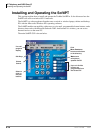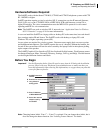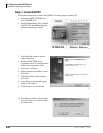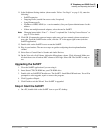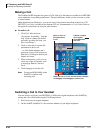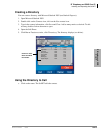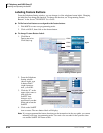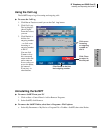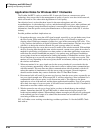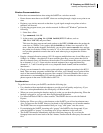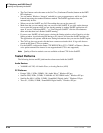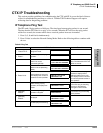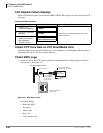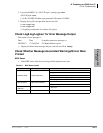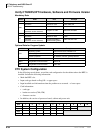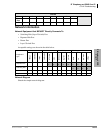
IP Telephony and QSIG Over IP
Installing and Operating the SoftIPT
9-26 Strata CTX I&M 06/04
Application Notes for Wireless 802.11 Networks
The Toshiba SoftIPT™ works on wireless 802.11 networks. However, current access point
technology does not provide for the management of quality of service over the wireless network,
which can result in a few observable degradations in voice quality.
Our objective here is to describe these issues for the network engineer, and offer some
recommendations. As the technology evolves, and the knowledge base grows, other problems and
solutions will emerge, hence the network engineer is encouraged to search out other sources of
information, from the specific access point manufacturers or from experts in the 802.11 wireless
industry.
Possible problems and their implications are:
1. Dropped packets may occur due to RF signal strength, especially as you get further away from
the access point. When small amounts of packet loss occur, you will notice a popping or
clipping sound. With larger amounts of packet loss, gaps in the conversation will occur. This
is very similar to the behavior of digital cell phones in the same situations. The best way to deal
with this is to design the wireless network for good coverage where it is needed.
2. Dropped packets may also occur due to excessive traffic on the wireless network. With multiple
devices accessing data through the same wireless network, current access points do not have a
method for prioritizing voice packets over data packets so when data applications create more
traffic than the wireless bandwidth can sustain, voice packets may get dropped. In addition,
access points do not have a mechanism for limiting the number of simultaneous sessions. In our
lab we find that up to seven calls can take place simultaneously on a single access point. This
number will vary depending on the access point, the RF environment, and any other activity in
the wireless environment.
3. When one terminal is in a poor signal area for the access point that it is associated with, the
access point may automatically reduce its data rate in order to achieve better communications
with that terminal. This new data rate affects communications with all terminals, which will
reduce the number of simultaneous calls the access point can support. Network engineers
should consider whether they want to disable the Auto TX Data Rate Feature.
4. Disconnected calls will result if you move too far away from the access point, or generally are
in a poor signal strength area. With current 802.11 wireless technology, when a terminal can’t
communicate with an access point, it will disassociate with it. This appears to the phone
application as a loss of the network, and the phone application disconnects. Even if you quickly
move back into range of an access point, it will take several seconds for the 802.11 terminal to
detect and re-associate with the access point.
5. Wireless networks can only get so large, before you have to break them up into multiple
subnets. Somewhere between 256 and 1000 nodes is where networks begin to need to be
broken up into multiple subnets. When multiple subnets are employed, the call will get dropped
as the terminal gets out of range of its subnet. But the terminal can reestablish its call after
associating with the new subnet.
FYI: At Toshiba we are working on technology to address problems 2~4 for the SoftIPT. Check
back with us.



